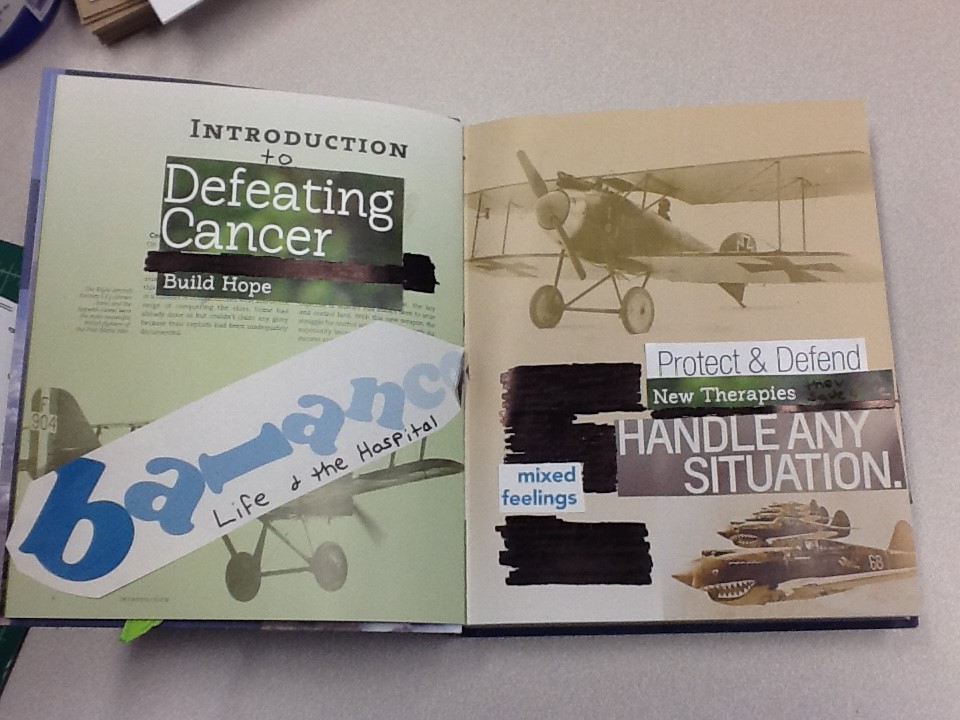By Abbien Crowley Ciucci, MA, ATR-BC, LPC and Hope Heffner, MA, ATR-BC, LPC | November 18, 2015 | Health Care | Children
The diagnosis of a serious illness is often life-altering. When given to a child, the news of disease can be indescribable. The story of hope that parents had written for their child may be disrupted with a few words. Whether newly diagnosed, or informed of a relapse, parents and caregivers might find themselves asking, what’s next? The engagement in treatment or return to the hospital can feel like another chapter in a daunting and distressing story. Separation from family, financial strain, and lack of sleep contribute to caregiver stress, all while a child suffers needle pricks and surgeries; helplessness and hopelessness can threaten to overwhelm. Thus, the need for a unique and accessible, but non-threatening, therapeutic support for caregivers was recognized.

Acknowledging altered book-making as an impactful way for caregivers to explore their journey through metaphor, The Next Chapter was started by two art therapists at The Children’s Hospital of Philadelphia. Created for parents and caregivers of pediatric patients, the group meets on the oncology/BMT unit bi-monthly. Although initially identified as a support for relapsed families, the group remains open to all unit caregivers experiencing an inpatient hospitalization. Mothers, fathers, grandparents, aunts/uncles, and friends have equally been invited to be a part of the group. It is advertised on flyers and through individual conversations as a space for parents and caregivers to socially connect, explore experiences, and find comfort through art-making.
Altered bookmaking was chosen as the identified art therapy method in the group for several reasons. The book itself acts as a container, which can be opened and closed, inherently providing safety and control. Private at first, but easily shared, an altered book can conveniently make the many journeys back and forth to the hospital. The written words and images act as starting points, providing caregivers with the structure and opportunity to eliminate, change, or maintain the existing contents. Metaphor is woven throughout the experience, allowing the caregivers to re-write, alter, or adapt the story as they see fit.
Amongst stacks of books and art materials, parents and caregivers can be found gathered in a unit conference room, not far from the constant beeping of monitors. At the start of the hour, the art therapists provide a brief background regarding the process and flexibility within this specific art technique. After introducing various ways to consider the experience, caregivers are provided with the choice of which book to alter. Parents are encouraged to identify books they are drawn to, whether they relate to the title, the subject, the images, or the feel. Classic children’s tales, fiction and nonfiction, as well as books chosen for their unique construction are passed around the table. Due to the unique needs of the hospitalized children, whom are largely immunosuppressed, the books are all brand new so caregivers can continue working on their piece within the walls of their child’s room without fear of contamination.
Throughout the group, the art therapists welcome conversation, which may reflect the art making process or the experience of caring for a hospitalized child. Discussion may arise between parents when certain books or themes are chosen, sparking connections. The group holds the opportunity to promote laughter or tears, reminiscence about the past or ambiguity with the future. Conversations with other adults in the medical setting often reference the trauma of illness. Discussion surrounds diagnosis, numbers, and treatments. A child’s illness becomes the focus, rather than the child themselves. Books are created for release and expression, but also for dedication and sharing. The art reaches beyond medical facts, to capture who a child is and what a caregiver hopes for them.
